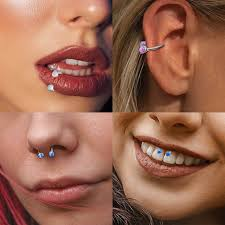Contents
- 1 What type of piercing is this?
- 2 Can everyone get it?
- 3 What types of jewelry are used for this piercing?
- 4 What material options are available for your jewelry?
- 5 How much does this piercing usually cost?
- 6 How is this piercing done?
- 7 Will it hurt?
- 8 What risks are associated with this piercing?
- 9 How long does it take to heal?
- 10 Cleaning and care
- 11 What to do:
- 12 What to avoid:
- 13 Symptoms to watch for
- 14 Signs of Infection:
- 15 Signs of Rejection:
- 16 How long will a healed piercing last?
- 17 How to change your jewelry
- 18 How to retire the piercing
- 19 Talk to your prospective piercer
What type of piercing is this?
A smiley piercing is a type of oral piercing that passes through the frenulum, the small strip of skin that connects the upper lip to the upper gum. This piercing is discreet and often goes unnoticed until you smile, which is why it’s called the “smiley piercing”. Known for its subtle and unique placement, the smiley piercing offers a fun, edgy look that becomes visible when you show your smile. It’s an ideal choice for those seeking a piercing that’s not overly noticeable yet adds a touch of personality when you flash a grin.
Can everyone get it?

Your piercer will assess whether you’re a suitable candidate for a smiley piercing based on your unique oral anatomy. Certain factors may disqualify you, such as having braces or an inadequately sized frenulum. Additionally, oral conditions like gum disease, dental sealants, and periodontitis can prevent you from getting this piercing. It’s important to have a healthy mouth and gums to ensure a successful and safe piercing process. A professional piercer will evaluate these conditions to determine if you’re a good fit for the smiley piercing.
What types of jewelry are used for this piercing?
- Captive bead ring: This is one of the most common jewelry choices for a new smiley piercing. It features a circular shape and is closed with a small bead, making it ideal for initial healing. This design offers a sleek and simple look.
- Circular barbell: Another option for your first piece of jewelry is a circular barbell. Shaped like a horseshoe, this jewelry has beads at both ends to secure it in place. It’s a versatile and comfortable choice for a variety of piercing placements, including the smiley.
- Seamless ring: Once your piercing has fully healed, you may choose to swap your jewelry for a seamless ring. This ring connects without the need for a bead to hold it in place, offering a clean, smooth appearance. You can also choose a seamless ring with added adornments to personalize your piercing further.
Choosing the right jewelry ensures that your smiley piercing heals properly and enhances your unique style. Always consult with your piercer for guidance on the best jewelry options for both healing and aesthetic preferences.
What material options are available for your jewelry?
Your piercer will discuss various material options for your smiley piercing jewelry to ensure both comfort and safety. Some of the most common materials include:
- Surgical titanium: Often recommended for those with sensitive skin, titanium is a lightweight, hypoallergenic material that is less likely to cause irritation or allergic reactions, making it an excellent choice for initial piercings.
- Surgical stainless steel: While surgical steel is generally considered hypoallergenic, there is still a chance of irritation for some individuals. This material is durable and commonly used for many types of piercings but may not be the best option for those with highly sensitive skin.
- Niobium: A hypoallergenic metal, niobium is another great option for people with sensitivities. It’s highly resistant to corrosion and is a safe choice for smiley piercings.
- Gold: If you prefer gold jewelry, be sure to select a high-quality option, such as 14-karat yellow or white gold. Gold that is higher than 18 karats may not be as durable, and gold-plated jewelry can cause infections or allergic reactions, particularly during the healing process.
Choosing the right material is essential for healing, comfort, and overall piercing health. Always consult with your piercer to ensure you select the most suitable material for your smiley piercing..
How much does this piercing usually cost?
When budgeting for your smiley piercing, don’t forget to inquire about potential aftercare costs, such as the price of a saline solution or other recommended healing products. Proper aftercare is essential to ensure the health of your piercing and to avoid complications during the healing process. Always clarify these extra expenses with your piercer before proceeding.
How is this piercing done?
- Antibacterial rinse: To ensure a clean environment for the piercing, your piercer will first provide you with an antibacterial mouthwash to rinse your mouth.
- Lip positioning: Once your mouth is clean, the piercer will gently pull back your upper lip to expose the frenulum, the small piece of skin connecting your upper lip to your gums.
- Piercing the frenulum: Using a sterile needle, your piercer will create a small hole in the frenulum. This step is typically quick and relatively painless.
- Inserting the jewelry: Once the hole is made, your piercer will thread the jewelry through the hole. If necessary, they’ll attach and secure the beads or other components to keep the jewelry in place.
The procedure is straightforward, but it’s important to follow aftercare instructions carefully to ensure proper healing and avoid complications. Always trust a professional piercer to handle the process safely and effectively.
Will it hurt?
Your pain tolerance also plays a significant role in how much discomfort you feel. The good news is that the needle part of the procedure is over quickly—usually lasting just a few seconds. After taking a deep breath in and out, the sharpest part of the process will be behind you. Many find that the pain is manageable and quickly fades, leaving you with a beautiful smiley piercing to show off.
What risks are associated with this piercing?
- Gum Damage: If your smiley piercing is placed incorrectly or the jewelry rubs against your gums, it could lead to gum recession over time. This can damage your gum tissue and create long-term oral health issues.
- Enamel Damage: Larger jewelry beads or attachments that come into contact with your teeth can cause damage to your tooth enamel. Constant friction from improperly fitting jewelry can result in wear and tear on your teeth.
- Infection: The mouth is a breeding ground for bacteria, especially after eating, drinking, or engaging in oral activities such as kissing or smoking. If bacteria enter the piercing site, it can lead to a serious infection, which may delay healing.
- Rejection: In some cases, your body may perceive the jewelry as a foreign object. As a result, it might reject the piercing by producing additional tissue to push the jewelry out of the frenulum, potentially leading to piercing migration or loss.
Taking the time to choose a skilled piercer and following proper aftercare can help minimize these risks and ensure a successful healing process.
How long does it take to heal?
A dermal piercing generally heals within 4 to 12 weeks, but the healing time can be longer if you don’t follow your piercer’s aftercare instructions carefully. During the first few weeks, it’s normal to experience mild pain and swelling around the piercing site. However, these symptoms will gradually subside as the healing process progresses.
While some discomfort is typical, you should be concerned if you notice yellow or green pus oozing from the piercing, the area feels hot to the touch, or if you observe other signs of infection. If these symptoms occur, it’s essential to seek professional advice to avoid complications and ensure proper healing.
.
Cleaning and care
What to do:
- Clean your mouth using a sea salt or saline solution twice daily to maintain oral hygiene.
- Rinse your mouth with water after eating to remove any leftover food particles.
- Brush your teeth twice daily, but be gentle around the piercing.
- Opt for a mild-flavored toothpaste (e.g., bubblegum) instead of mint, as mint can irritate the piercing.
- Use an alcohol-free mouthwash to avoid irritation.
- Limit talking during the first few days to prevent irritation around the piercing.
What to avoid:
- Avoid touching the piercing or playing with the jewelry, as this can introduce bacteria and slow healing.
- Refrain from drinking alcohol, as it can irritate the piercing and affect the healing process.
- Smoking can expose the piercing to harmful bacteria and delay healing.
- Steer clear of alcohol-based mouth rinses or toothpastes that can dry out and irritate the area.
- Avoid hot or spicy foods that can cause irritation or discomfort.
- Limit acidic foods like tomatoes that can aggravate the piercing.
- Skip hard or crunchy foods that could damage or disturb the piercing.
- Avoid kissing, as it can introduce bacteria into the healing site and affect the jewelry.
- Refrain from activities that could move the jewelry around, such as playing wind instruments, which could disturb the piercing.
By following these steps, you’ll ensure that your smiley piercing heals properly and without complications.
Symptoms to watch for
Signs of Infection:
- Redness spreading beyond the piercing site.
- Severe pain that doesn’t subside.
- Intense swelling that worsens over time.
- Yellow or green discharge from the piercing.
- Unpleasant odor emanating from the area.
Signs of Rejection:
- Jewelry displacement—the jewelry moves out of its intended position.
- Jewelry that hangs or droops.
- Complete dislodgement of the jewelry, indicating that the body is rejecting the piercing.
If you notice any of these concerning symptoms, it’s essential to seek professional help promptly to prevent complications and ensure proper healing of your piercing
How long will a healed piercing last?
Proper aftercare can certainly improve the chances of your piercing lasting longer, but it’s important to note that there is no guarantee for long-term durability. Factors such as healing time, jewelry quality, and individual anatomy all play a role in determining how long your smiley piercing will remain intact.
How to change your jewelry
If you choose to change your jewelry at home, make sure to follow these careful steps to reduce the risk of infection and damage:
- Rinse your mouth with a sea salt or saline solution to ensure the area is clean.
- Wash your hands thoroughly with antibacterial soap before touching the piercing.
- Gently unscrew the existing jewelry, ensuring you don’t put pressure on the piercing.
- Quickly and carefully thread the new jewelry through the hole to avoid irritation.
- Secure the jewelry by screwing any beads onto it or fastening it as required.
- Rinse your mouth again with a sea salt or saline solution to promote cleanliness and prevent bacteria buildup.
By following these steps carefully, you can safely change your smiley piercing jewelry while maintaining its health and healing process.
How to retire the piercing
Removing the jewelry after the piercing has completely healed is a much simpler process. Once healed, you can simply take out the jewelry, and the hole will gradually close on its own without the need for further care. Just ensure that the piercing is fully healed to avoid any issues during the removal process.
Talk to your prospective piercer
Getting a smiley piercing can be an exciting decision, but it’s important to consult with a couple of reputable piercers before moving forward. They will not only provide you with pricing details but also assess whether your frenulum tissue is thick enough to support the piercing. If your frenulum is too thin, your piercer may recommend a different piercing option that will be a better fit for you in the long term.
Your piercer should always be your primary source for any questions about the healing process, potential side effects, and any other concerns that arise. Make sure you fully understand the procedure and aftercare requirements before getting your piercing, as this will help ensure a smooth and successful experience.








